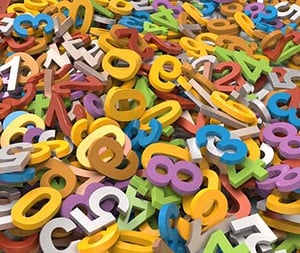Patent numbers: what do they tell you?
 How can I possibly tell all those numbers apart?" is what one of my clients recently said about patent numbers with a sigh. Every patent application has a patent number and on top of that part of this number changes during the granting procedure. These numbers may appear to be a random collection of numbers and letters, but appearances can be deceptive. Patent numbers have a meaning and provide you with information about the countries in which a patent has been applied for and about the status. This is useful when you are looking into your competitor’s patent portfolio, for instance. Time to take a more in-depth look at these patent numbers.
How can I possibly tell all those numbers apart?" is what one of my clients recently said about patent numbers with a sigh. Every patent application has a patent number and on top of that part of this number changes during the granting procedure. These numbers may appear to be a random collection of numbers and letters, but appearances can be deceptive. Patent numbers have a meaning and provide you with information about the countries in which a patent has been applied for and about the status. This is useful when you are looking into your competitor’s patent portfolio, for instance. Time to take a more in-depth look at these patent numbers.
Three parts
When you are working on an innovation, you obviously do not want to infringe someone else's patent. The information contained in patent numbers can help you with this. But also when you want to know what your competitors are up to it is nice to have a better understanding of patent numbers.
A patent number is always made up of three parts.
- A two-letter country code which provides information about the country of origin.
- The document number which tells you something about the patent family.
- The type number or kind code which provides information about the granting status.
For example: EP1356314A2
Country code
In the example provided, EP is the country code. EP stands for Europe: so it is a European patent document. Each country has its own code such as CN, US and WO. These particular codes stand for a Chinese, American and international patent respectively. This is interesting information because it tells you more about where the innovation will be protected if the patent is granted.
Type number
The type number, which is also referred to as the kind code, tells you more about the phase of the granting procedure. In other words: whether or not the patent has already been granted.
An A generally refers to the publication of a patent application, the actual patent itself will not have been granted at this point. In the case of a B, the patent will already have been granted.
In the example provided the type number is A2, which means that the patent application has not yet been granted. In the case of international and European patent applications, the number 2 indicates that it is a patent application without publication of a novelty report. If it says A1, there is a novelty report.
What to do in the case of a B document?
You have developed a new product and are trying to find out if it already exists. You obviously do not want to infringe a patent and get into trouble. What if you come across a patent number with a B in it?
In the case of a B document, the patent will have been granted but this does not automatically mean that it is in force in the country where you want to market your product. Even if there is a B document for the product in question and it has been validated in the country in question, this does not necessarily mean that you cannot bring your product into the market. Does your product really fall within the claims? Is there a possible workaround? Are there strong arguments against the validity of the patent? Or is it perhaps possible to obtain a licence agreement? You should talk to your patent attorney to see if this is the case.
Keep informed
As you can see here, patent numbers tell you more than you might think. An untrained reader may not fully understand what the numbers stand for. For example, the conditions for keeping a patent active. Or documents with the same number but with a difference in the claims and therefore the scope of protection. Are you trying to establish if you are at risk of infringing? Or are you having to deal with documents with different numbers yourself? Don't spend too much time worrying about this and get in touch with your patent attorney for some proper advice.
I would be pleased to provide you with more information, so do not hesitate to contact me. You can also chat with me or one of my colleagues on working days between 2pm and 5pm. If you go to www.epc.nl, the chat function will open automatically. We are there to answer your questions.

About the author
Driven by my fascination with biology, medicine, and medical technology, I studied technical medicine at the University of Twente. My Ph.D. and postdoctoral research at UMC Utrecht combined clinical...
More about Michiel >